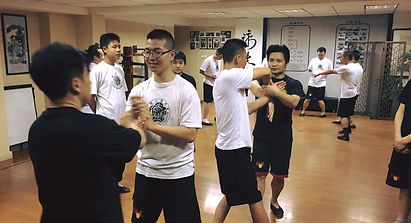課程內容 Curriculum
小念頭 The Little Idea Form
小念頭套拳及致用法 (首3至5個月)
詠春拳的拳術系統有別於一般武術門派。
我們可用學習英文作比喻。《小念頭》等如學習英文的26個字母。詠春祖師創立這套拳時,把很多「單式基本動作」在練習時合而為一;故此,門外漢如果只看套路的動作而沒有師傅的詳細解釋,根本是不能看得出套路裡所打的招式與實際搏鬥有何關係。
在這段期間,習者便能學完整套小念頭套拳及其致用法,例如連環拳及其發勁方式、步法,搏擊距離及如何應付直拳,擺拳,直踢、掃踢,擒拿等。
另外,學生亦會學到如何利用貼牆沙包,吊包及木人樁等鍛鍊功力。
The Little Idea Form & applications (3rd - 5th months)
WingTsun is different to many martial art systems.
Somehow, there is an analogy between the learning WingTsun and English language. "The Little Idea" form is similar to the 26 alphabets in English. It consists of the basic stance and all the fundamental hand techniques.
When our founder created this system, she combined many single techniques into a set. Therefore, without out the detailed explanations from an instructor, laymen can never tell the applications of the movments .
While we teach our students the form, we would show him the applications of each technique and how to train it, such as Chain-Punches and its way to exert elastic force, footwork (how to put your body mass into your strikes), fighting distance and means in dealing with straight-line punches, haymakers, straight-line kicks, roundhouse kicks, grappling, etc.
Apart from that, we would also instruct our students in how to obtain knockout punching and kicking power by Wallbags, heavy bag and wooden dummies.








尋橋 Bridge-Seeking Form
尋橋及致用法 (第六個月至八個月)
尋橋是詠春拳系統中的第二套拳。裡面包含的招式主要是防守技術。
「尋橋」, 顧名思義,是「尋找敵人橋手」的意思。如要成功地防禦敵人攻來的手法,首先要做到在對方打到自己之前接觸對方的攻手。我們學習功夫自衛,首要的是學會運用詠春招式保護自身,否則只會和對方互毆,造成兩敗俱傷的局面。
與「小念頭」不同,透過尋橋,習者會學到詠春拳的馬法、步法及如何把馬步配合;貼身攻擊招式如肘法,膝法等,亦包含在尋橋裡面。
此外,詠春拳三種基本的腿法亦包括在此套拳中。
所以練習尋橋,無疑會令詠春習者在防守方面加強及掌握更多攻擊技法。
Bridge-Seeking Form & appliacations (The 6th - 8th months)
Chum Kiu is the intermediate set in WingTsun and the techniques in it are mostly defensive. To protect ourselves , we should first intercept our enemy's limbs. Chum Kiu introduces various ways to achieve that.
Unlike the Little Idea Form, a student would learn the variations of stance, footwork, kicks and knee strikes in Chum Kiu.





黐手訓練 Chi-Sau (Arm-Clinging) Training
黐手訓練 (第9個月至第24個月)
在學完「小念頭」及其致用法,習者會學習「黐單手」。
實際搏擊時,敵人是不會告訴您他會如何攻擊你,用甚麼招式。所以,我們不能在打鬥時按練習套拳般,把招式按固定次序及組合逐式使用。黐手訓練就是把套拳裡的招式轉化成習者的條件反射反應(Conditioned Reflex actions)。
經過這個訓練,詠春習者不用再經過「眼看腦想手腳動」這個正常反應程序;而是按對方打來的拳腳力度、角度及位置等,根據條件反射反應自動化去做出適當的卸力消解及反攻。
本班所教授的黐手課程,有條理地分為七節,由梁挺宗師設計,並經過30多年的實踐,久經實用;每一節皆包括小念頭及尋橋中所分化出來的招式若干,有攻有守,生生不息。
第一節:基本搏擊手法及步法配合。
第二節:,擒拿及反擒拿法。
第三節:如何令對方失重心,借力打力的「撞打」之法。
第四節:雙拳的攻擊法及滾手的運用法。
第五節:「以打為消」、「跳橋搶攻」之法。
第六節:拂手的貼身攻擊及消解方法。
第七節:雙方由遠距離變為手搭手時的搶攻法。
Chi-Sau (Arm-Clinging ) Training (The 9th - 24th months)
After learning the Little Idea Form & its applications, the student would learn "Single-Arm Chi Sau " training. In real fights, your opponents would never tell you how he is going to attack you. Thus, we should not fight like the sequence we do in form practice. Through Chi-Sau training, we can turn all the techniques in the forms to our "conditioned reflex actions" and act according to various situations, angles, positions.
In our class, we teach the 7 Chi-Sau section programs developed by Great Grandmaster Leung Ting. These programs are proved practical after more than 30 years of practical experiences. The techniques are mostly from the Little Idea Form and Bridge-Seeking Form.
Section 1: Basic Offensive, defensive technqiues and footwork.
Section 2: Arm-locks and Anti-Arm-lock techniques.
Section 3: How to make your enemy lose his balance and attack him.
Section 4: Double punches and the applications of Rotating Arms Defence.
Section 5: How to "attack instead of defence" .
Section 6: The "Fak Sau"Whipping Arm attack and its defence.
Section 7: How to seize the 1st opportunity to attack from a distance.



甩手搏擊訓練 Lat-Sau Fighting Practice
甩手搏擊訓練習﹝第9至36個月﹞
第一節黐手課程鍛鍊純熟後,學員便可以體驗搏擊訓練。我們的搏擊訓練有兩種:
1. <甩手>
因為在真實打鬥中,敵人未必會和自己在手搭手或先黐一陣子手才攻擊你,
所以我們會循序漸進引導學員練習在手不搭手的距離搏擊,以鍛鍊習者的距離感,
視覺反應及如何使用及消解腳法等。
這種練習講究留力留手不留招。
練習對手甚至可以間或使出非詠春招式去訓練對方如何以詠春去消解。
2. <帶上護具的搏擊>
前者,後者在護具的保護下,學員能更真實體驗到自己及練習拍檔的力度及狠勁。
Lat Sau Fighting Training (The 9th - 36th months)
After a student has learnt up the 1st Chi-Sau section, he/she will learn how to apply the techniques in a free-fight scenario which both he/she and his/her partner start the fight from a distance that is beyond an arm can reach. There are 2 types of Fighting practice:
(1). "Lat-Sau" Bare-handed Fight practice
The practictioners would apply WingTsun techniques to attack each other but hold back their power as soon as the strikes land. One practitioner can also suddenly apply non-WingTsun attacks to his/her partner to train how he/she handle them with WT techniques.
(2). With Protective Gear
As both practictioners practise fighting with protective gear (Helmet with facial mask, body & grion protectors, combat gloves) on, they can try to hit each other without holding back.

標指套拳及致用法 Thrusting Fingers Set & Applications
標指及致用法(第48個月至60個月)
標指為詠春系統中最高級的套拳,以攻擊為主,主要有指法、掌法及肘法。整套子的招式皆是「以攻為守」、「以打為消」。往往籍著角度的偏差,配合如籐鞭的柔勁,險中求勝,所以招式被前兩首拳來得狠毒及效果迅速。
The Thrusting Fingers form and applications ( The 48th - 60th months)
The "Thrusting Fingers " program is regarded as the most advanced "empty-handed set in WingTsun. Most of the techniques in it are aggressive attacks including finger technqiues, palm and elbow strikes. "To attack instead of defence" or "The best defence is attack" is the main theme of it.



木人樁法及黐腳 Wooden Dummy Techniques & Sticking Legs
木人樁法及黐腳 (第72個月至96個月)
木人樁法共116式,其中16式為腳法。很多人以為詠春拳沒有腳法,其實整套詠春下盤功夫皆收歸在這套木人樁法中。
木人樁法的招式可謂詠春系統裡最上乘的手法。很多手法皆是用於克制同門的前三首套拳裡的招式。假若熟習木人樁法,就算一個功力較弱的習者,很多時也能戰勝比自己較強的同門。這就是法度上取勝了。
The wooden dummy program & Sticking Leg (The 72th - 96th months)
There are altogether 116 techniques in the wooden dummy program. Many people misunderstand that there is no kicking techniques in WingTsun, but actually the entire kicking, footwork, stance and knee technqiues are kept in this program.
If a WingTsun practictioner could comprehend the wooden dummy technqiues, he/she can defeat his peers who are physically stronger.




六點半棍法 Six & a Half Long Pole Techniques
六點半棍據說源自少林至善禪師,經由詠春先輩梁二娣傳及黃華寶時,黃把詠春心訣揉合其中,成為本派特式的棍法。
六點半棍簡潔明快,只有七招,但變化萬千。
It is said that the WingTsun Long Pole was orginated from Shaolin Temple. The founder of the Shaolin "6.5 Points Long Pole techniques" was created by Fighting Monk Chee-Shin. Generation after generation, The techniques were passed down to WingTsun master Wong Wah-Bo by Master Leung Yee-Tai. Master Wong modified the long pole techniques with WingTsun concepts and made the weapon system unique to WingTsun.
There are only 7 techniques in the Long Pole program, but the variations are numerous.

八斬刀法 WingTsun Double Knives
八斬刀為長僅及肘的短兵器,有護手鈎及護手柄之設。凡使用八斬刀必出成雙,互相照應,此攻彼守,其法至為毒辣。
八斬刀共分為八節的攻守方式,每節各有不同的效能,以應付各種不同的武器。
WingTsun Double Knives program has been regarded as the top secret in the WingTsun system. The knives contain a pair of metal hooks and D-shaped guards around the handles to protect the user's hands.
In Chinese, 八 means "Eight" 斬 means "chopping" 刀 means "Knives/swords". Therefore, 八斬刀 means "Eight ways of Chopping Knives". There are 8 sections in total for the program. The techniques and functions of each section vary and are used to deal with different kinds of weapon.



